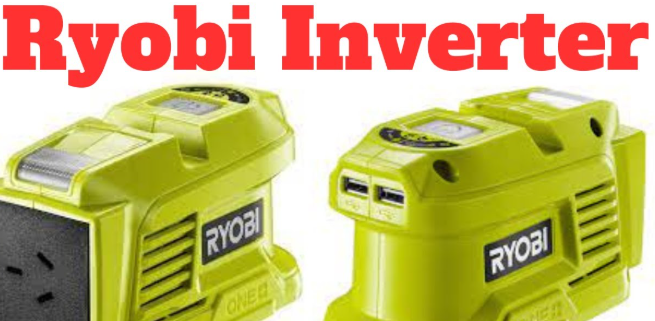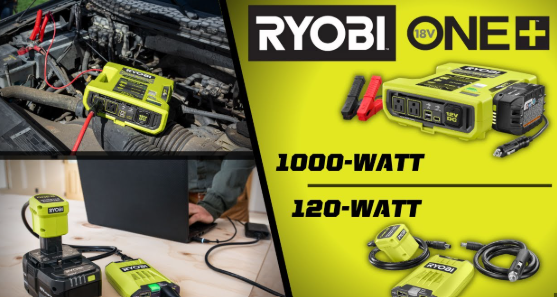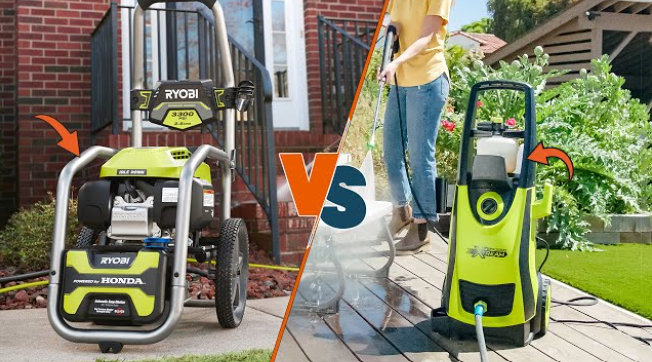How to Turn On Ryobi Power Inverter?
A Ryobi power inverter is a handy tool that converts battery power into usable electricity. It helps you run lights, charge phones, or power small tools during camping, power cuts, or outdoor projects.
Ryobi makes different inverter models such as the RYOBI ONE+ 150W, 300W, 800W, and 1000W, but they all work in a similar way. Understanding how to turn it on properly is important for both safety and performance.
A small mistake like wrong battery placement or overloading can cause the inverter to shut off. So, learning the right steps helps you use your inverter correctly every time.
This guide explains how to turn on a Ryobi power inverter step by step, what to check before using it, and how to troubleshoot common issues.
What Is a Ryobi Power Inverter?

A Ryobi power inverter changes battery power (DC) into normal plug power (AC). That means you can use your Ryobi battery to run things that normally need a wall outlet.
For example:
-
Charge your phone or tablet.
-
Power a lamp or small fan.
-
Run a laptop or small radio.
-
Charge power tools on the go.
It is portable and easy to carry. You only need a Ryobi battery to make it work.
Main Parts of the Inverter
Knowing the parts helps you understand how it works.
-
Battery Slot: Where you insert your Ryobi battery.
-
Power Button: Turns the inverter on and off.
-
AC Outlet: Where you plug in normal home devices.
-
USB Ports: For charging phones, tablets, or speakers.
-
LED Light: Shows if the inverter is on, off, or has a problem.
Each part has its job. Together, they help the inverter supply power smoothly.
Before You Turn It On
Before pressing the power button, check a few small things. These steps help the inverter run safely and last longer.
1. Check the Battery
A weak or dead battery will not start the inverter.
-
Make sure the battery is charged.
-
Press the battery’s small indicator button to check its level.
-
Charge it fully if the lights show low power.
A full battery gives better performance and longer runtime.
2. Inspect the Inverter
Look at the inverter carefully.
-
Is it clean?
-
Is there dust or water near the ports?
-
Are there any cracks or broken parts?
Wipe it with a dry cloth if needed. Never use wet hands. Electricity and water are dangerous together.
3. Know the Power Limit
Each inverter model supports a specific watt limit.
-
150W model: Best for small devices like phones or fans.
-
300W model: Can handle laptops and lights.
-
800W or 1000W model: Can power larger tools or small TVs.
Always check your device’s watt use before plugging it in. Too much load can stop the inverter or damage it.
4. Find a Safe Spot
Put the inverter on a dry, flat surface. Avoid soft places like beds or grass because they block air flow. Heat must move out easily for the inverter to stay cool.
Once all looks fine, you are ready to start.
How to Turn On Ryobi Power Inverter

Let’s go step by step. Each step is simple but important.
Step 1: Insert the Battery
Take your charged Ryobi battery.
-
Line it up with the slot on the inverter.
-
Slide it in until it clicks.
-
Make sure it feels firm and secure.
If the battery is loose, the inverter will not power up.
Step 2: Connect Your Device
Now connect the item you want to use.
-
Plug a phone cable into the USB port.
-
Plug a light or fan into the AC outlet.
Do not connect too many devices. Use one or two small ones at a time. Stay below 90% of the inverter’s rated power.
Step 3: Turn On the Inverter
Find the power button on the inverter’s top or side.
Press and hold it for about 2 seconds.
-
If the light turns green, it means the inverter is on and working.
-
If the light turns red or flashes, it means the battery is low or there is an overload problem.
Once the green light is on, your inverter is ready. The device you connected should start running.
Step 4: Turn It Off Safely
After you finish using it:
-
Press the power button again to turn it off.
-
Unplug all devices.
-
Remove the battery if you will not use it for a long time.
This stops slow battery drain and keeps both battery and inverter safe.
How Different Ryobi Inverter Models Work

Ryobi makes several inverter sizes. The way to turn them on is mostly the same, but each has small differences.
Ryobi 150W Power Inverter (RYi150BG)
-
Uses one 18V ONE+ battery.
-
Has one AC outlet and two USB ports.
-
Press the top green button for 1–2 seconds to turn on.
Ryobi 300W Power Inverter
-
Works with both 18V and 40V batteries.
-
Comes with two AC outlets.
-
Hold the main button for 2 seconds to power up.
Ryobi 800W / 1000W Power Station
-
Uses two or more batteries at once for longer runtime.
-
Has an LCD screen that shows power levels and warnings.
-
Press the button near the screen to start.
These larger models can run more than one device at a time.
Tips for Safe Use
-
Keep the inverter away from water and moisture.
-
Do not use near fire or heat.
-
Make sure there is space for air to move.
-
Avoid plugging in heavy tools like heaters or large TVs.
-
Unplug everything before storing.
-
Always use Ryobi batteries, not third-party ones.
Safety always comes first. It keeps both you and the inverter safe.
Troubleshooting Common Problems
Sometimes the inverter may not work as expected. Here’s how to fix simple problems.
1. The Inverter Does Not Turn On
-
Check that the battery is charged.
-
Make sure the battery is fully pushed into place.
-
Press and hold the power button long enough (1–2 seconds).
If it still does not work, clean the contacts and try again.
2. The Light Turns Red
-
This means overload or low battery.
-
Remove some devices and press the button again.
-
Recharge the battery if it’s nearly empty.
3. Device Is Not Charging
-
Check if the inverter is turned on.
-
Try another cable or device.
-
Make sure you use the right port (USB or AC).
4. The Inverter Turns Off Suddenly
-
It may have overheated or reached its power limit.
-
Let it cool down for 10–15 minutes before restarting.
5. USB Port Not Working
-
Check if the inverter light is green.
-
Try another cable or port.
-
Clean the USB port with a soft dry brush.
Maintenance Tips
Proper care makes your inverter last longer.
-
Keep it dry at all times.
-
Clean it gently after each use.
-
Do not store it in direct sunlight.
-
Keep the battery contacts dust-free.
-
Store the inverter and batteries separately in a cool place.
-
Recharge the batteries every few months even if not used.
A few minutes of care after each use can extend the life of your inverter for years.
Best Places to Use Ryobi Power Inverter
This small device can help in many situations:
-
Camping: Power a fan, phone, or small light.
-
Travel: Charge gadgets inside the car or tent.
-
Work Sites: Run small tools or lights where power is not available.
-
Power Outages: Keep phones or emergency lights running.
-
Outdoor Events: Power a speaker or projector for a short time.
It’s quiet, clean, and easy to carry. No smell or noise like a gas generator.
FAQs
1. Can I use any Ryobi battery with the inverter?
Most inverters use Ryobi 18V ONE+ batteries. Some bigger models work with 40V batteries too.
2. How long can it run on one battery?
It depends on battery size and load. A 4Ah battery can power a laptop for about 45 minutes to 1 hour.
3. The light keeps flashing red. What does it mean?
That means the inverter has an overload or low battery. Remove the load and recharge the battery.
4. Can I charge the Ryobi battery using the inverter?
No. The inverter gives power; it cannot charge batteries. Use a Ryobi charger instead.
5. Is it safe to keep it on overnight?
No. Always turn it off after use to avoid battery drain and overheating.
6. Can it power a refrigerator or microwave?
No. Those need too much power. The inverter is for small items only.
7. What should I do if it gets hot?
Turn it off and wait 10–15 minutes. Make sure it’s in a cool, open space.
8. Can I plug in two devices together?
Yes, but check that the total watt use is less than what your inverter can handle.
9. Does it drain the battery even when off?
Very little. But it’s better to remove the battery during storage.
10. How do I know it’s working properly?
The green light stays on, and your device starts charging or running.
Conclusion
A Ryobi power inverter is a smart and simple way to get electricity anywhere. It’s easy to use once you understand the steps. Just charge your battery, plug it in, connect your device, and press the button. The green light shows it’s ready.
Always stay within the power limits and keep it dry. If something goes wrong, small checks like recharging the battery or removing extra load often fix the issue.
This small tool can make life easier during travel, outdoor work, or power cuts. With proper care and use, your Ryobi inverter will serve you well for many years.







